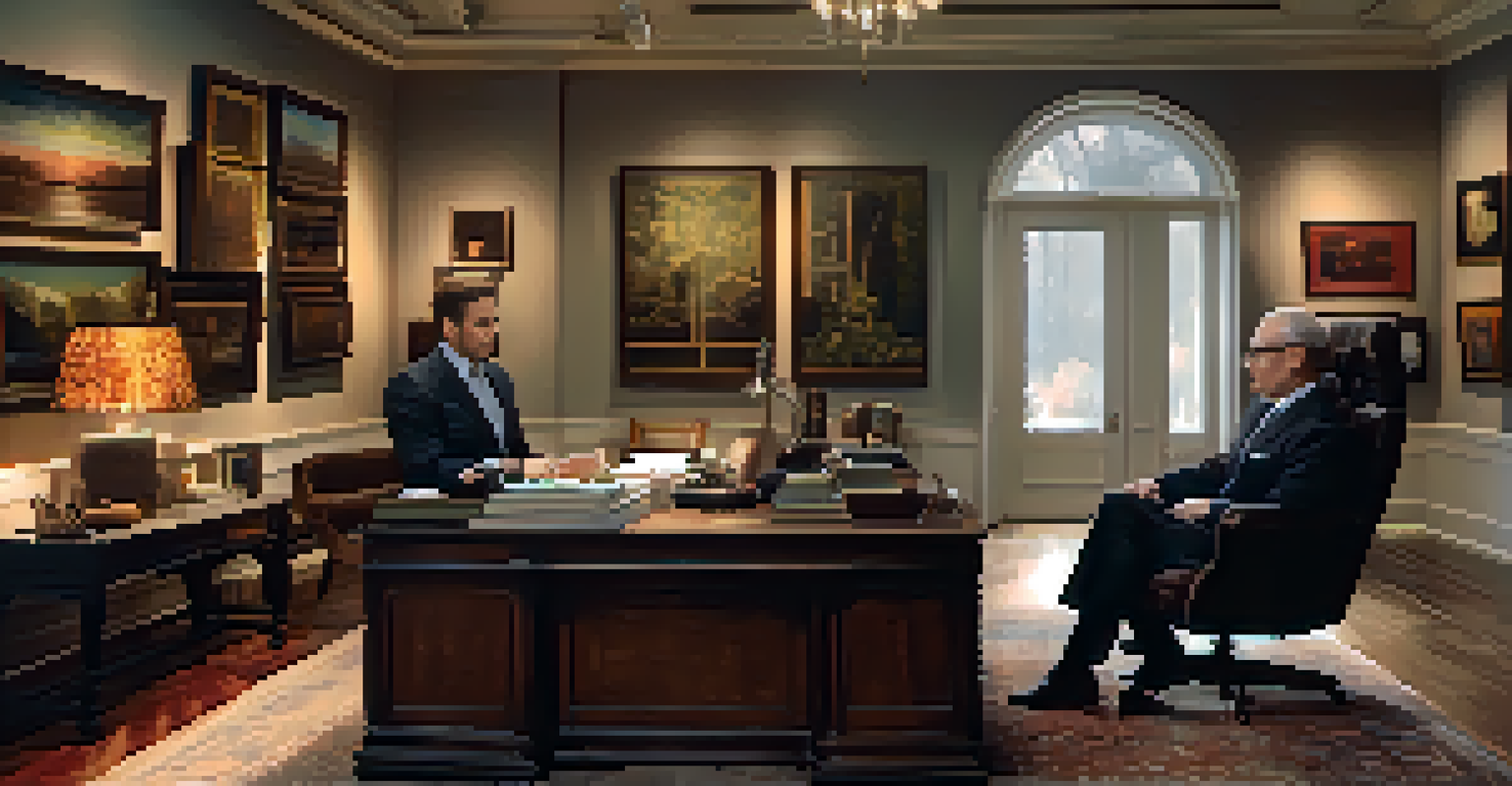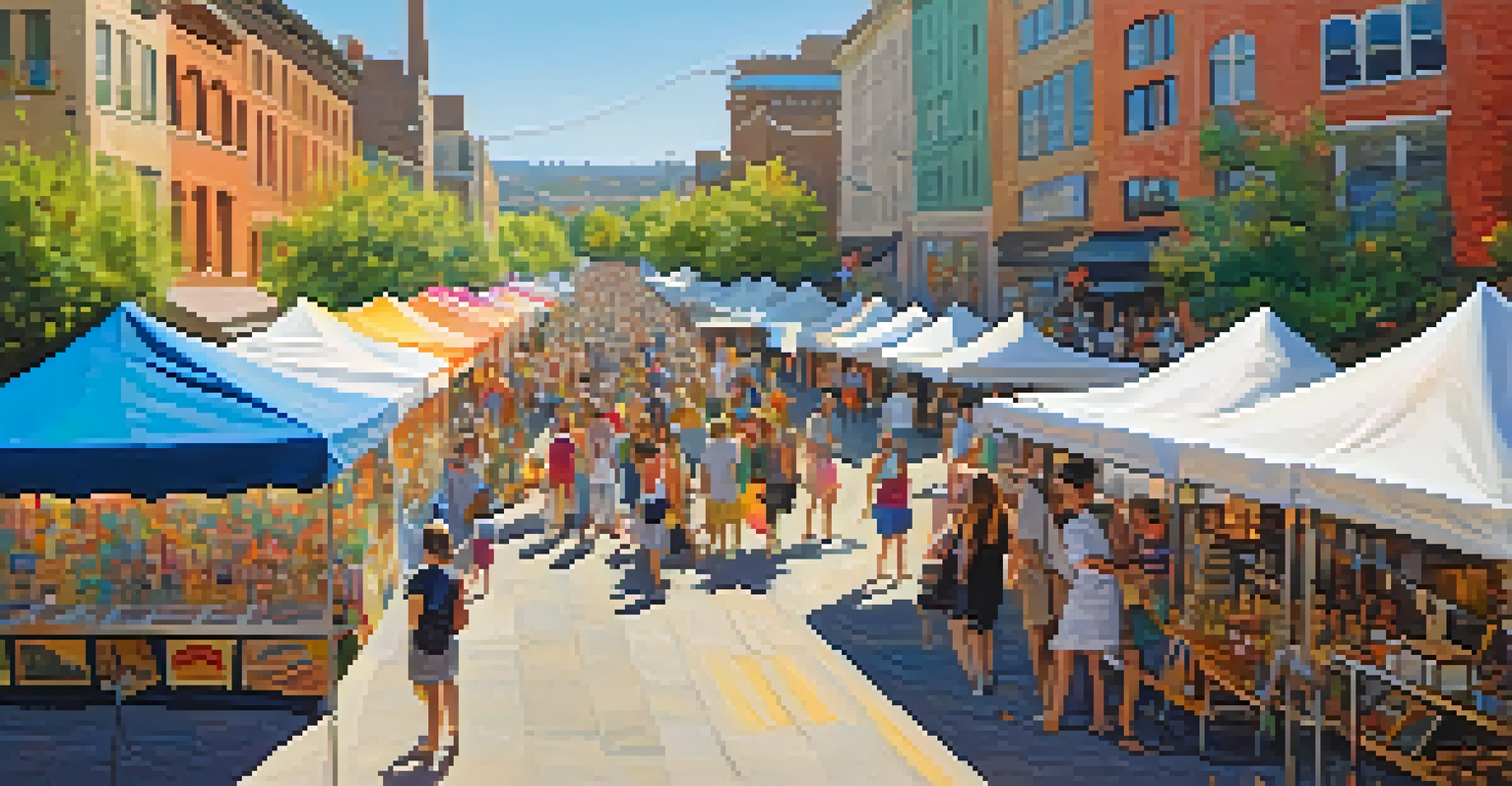Art and Investment: Understanding the Financial Aspects

The Intersection of Art and Finance: An Overview
Art has long been considered a luxury, but it’s increasingly seen as a viable investment. This intersection of art and finance allows collectors to not only enjoy beautiful works but also potentially enhance their wealth. Many investors are beginning to realize that the art market can yield impressive returns, often outperforming traditional investments like stocks and bonds.
Art is not a thing, it is a way.
With the rise of online platforms, access to art investment opportunities has never been easier. Art fairs, galleries, and auctions now cater to a broader audience, inviting both seasoned collectors and newcomers. This democratization of the art world encourages diverse investments, making it essential to understand the financial implications.
However, like any investment, art comes with its risks and complexities. Market fluctuations, authenticity issues, and changing tastes can all impact the value of artwork. Therefore, it’s crucial to approach art investment with a blend of passion and practicality.
Understanding Art Valuation: What Makes Art Valuable?
Valuing art isn't as straightforward as it might seem. Unlike stocks, which have clear market prices, art valuation combines subjective factors like aesthetics, artist reputation, and historical significance. This complexity can make it challenging for investors to determine the worth of a piece.

The provenance, or history of ownership, plays a vital role in establishing value. A well-documented history can significantly boost an artwork's price, as collectors often seek pieces with interesting backstories. Furthermore, the rarity and condition of a piece also influence its valuation, making thorough research essential.
Art as a Valuable Investment
The art market offers potential for impressive returns, attracting both seasoned collectors and newcomers.
Investors should also consider market trends when assessing value. Just as fashion changes, so do art preferences. Staying informed about current trends can help collectors make better purchasing decisions and potentially increase their investment returns.
The Risks of Investing in Art: What to Watch Out For
Every investment carries risks, and art is no exception. One of the most significant challenges in art investment is market volatility. Art prices can fluctuate dramatically based on trends, economic conditions, and even global events. This unpredictability can lead to potential losses for investors.
The best artist has no conception that a marble block does not contain within itself the idea of a statue.
Additionally, the authenticity of a piece can be a major concern. Counterfeit artworks can be difficult to spot, and without proper documentation, investors risk purchasing something that isn’t genuine. Engaging with reputable galleries and experts can help mitigate this risk.
Another factor to consider is the illiquidity of art. Unlike stocks that can be bought and sold quickly, art requires a longer time frame to find the right buyer. Investors should be prepared for the possibility that they may not be able to liquidate their investment as quickly as they would like.
Building a Diverse Art Collection: Strategies for Success
Diversity is key in any investment portfolio, and art collections are no different. By collecting artworks from various genres, periods, and artists, investors can spread risk and enhance their chances of financial success. This approach not only makes for a more interesting collection but can also provide more stable returns.
Investors should also consider the balance between established and emerging artists. While well-known artists may offer stability, young and emerging artists can provide exciting growth potential. Keeping an eye on new talent can lead to discovering hidden gems that appreciate significantly over time.
Understanding Art Valuation
Art valuation involves subjective factors such as aesthetics and provenance, making thorough research essential for investors.
Moreover, attending exhibitions and art fairs is an excellent way to stay informed about the art market while building connections with artists and other collectors. Networking in the art community can lead to valuable insights and opportunities that may not be available through traditional investment channels.
The Role of Art Advisors: When to Seek Professional Help
Navigating the art market can be overwhelming, especially for novice investors. This is where art advisors come into play. These professionals can provide invaluable guidance on purchasing, valuing, and even selling artworks, ensuring that investors make informed decisions.
Art advisors often have extensive networks and access to exclusive artworks, which can give investors a competitive edge. They can also assist in curating a collection that aligns with an investor’s personal taste and financial goals. This tailored approach can enhance both the enjoyment and potential profitability of an art collection.
However, it's important for investors to choose advisors wisely. Researching their credentials, past successes, and areas of expertise can help ensure that the partnership is beneficial. Finding the right advisor can make a significant difference in the overall investment experience.
The Impact of Technology on Art Investment
Technology is revolutionizing the art investment landscape, making it more accessible and efficient. Online platforms now allow investors to browse and purchase artwork from around the globe, breaking down geographical barriers. This shift has opened up new avenues for investment and has democratized access to the art market.
Moreover, blockchain technology is making waves in the art world by ensuring authenticity and provenance. Digital certificates of authenticity can be stored on the blockchain, providing buyers with peace of mind regarding their investments. This innovation can significantly reduce the risk of fraud, a common concern in art transactions.
Navigating Risks in Art Investment
Market volatility, authenticity concerns, and illiquidity are significant risks that investors should carefully consider.
Additionally, social media is playing a critical role in shaping art trends and values. Artists can now showcase their work directly to potential buyers, bypassing traditional gatekeepers. This direct connection between artists and collectors can lead to increased visibility and potentially higher demand for unique pieces.
Final Thoughts: Balancing Passion and Profit in Art Investment
Investing in art can be a rewarding endeavor, both financially and emotionally. However, it’s essential to strike a balance between passion for art and the pursuit of profit. Collectors who genuinely appreciate the artwork they invest in are often more satisfied, regardless of financial returns.
Keeping a long-term perspective is crucial in art investment. While short-term trends may tempt investors, the true value of art often emerges over time. Patience, combined with informed decision-making, can lead to a successful and fulfilling investment journey.

Ultimately, art investment should be approached with curiosity and enthusiasm. By educating themselves, engaging with the art community, and remaining open to new experiences, investors can cultivate a collection that not only reflects their taste but also holds potential for financial growth.